|
How N Scale Couplers Variations
for Model Railroads
N-scale is one of the most popular scales that
modelers work on. It ranges from 1:148 to 1:160 depending upon the country and the manufacturer of
the train. In this scale, the distance between the rails of the train is 9 mm (equivalent to 0.354
inches). In the UK, the term N gauge refers to 1:160 (9 mm) track gauge modeling on a 1:148
scale.
Even though the terms N-gauge and N-scale are
used interchangeably, they do not mean the same thing. While the term N-scale means the proportion
of ratio to be used in the model, the term N-gauge technically refers to the gauge distance between
the rails of the train. For ease of material exchange, the scale of 1:148 is used for rail to rail
gauge.
|
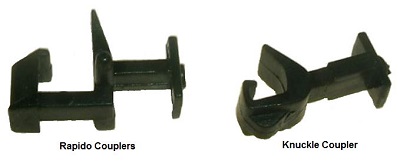
Even though both of these are N
scale couplers, they are not compatible with each other. Knuckle couplers are more
recent, and are available in a wide range. All of these varieties of knuckle
couplers are incompatible with Rapido couplers, and most, are incompatible with
other brands of Knuckle couplers. Rapido couplers are considered the original
N-scale couplers.
|
Types of N Scale Couplers When
building a model railroad, it is important to consider N scale couplers. Once the
scale of the model is determined, the next step is to ensure the couplers on the
locomotives and the cars available are compatible. In the N scale setting, there
are mainly 2 types of couplers:
1. Rapido
2. Knuckle
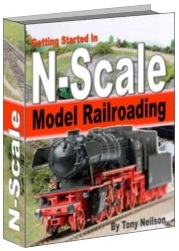
Download your N scale E-book Now
|
How Couplers Work
In real life and on model railroads the
function of couplers is to join the engine (locomotive) to the car directly behind it, and then to
join each car in the train to the car directly in front of, or behind it.
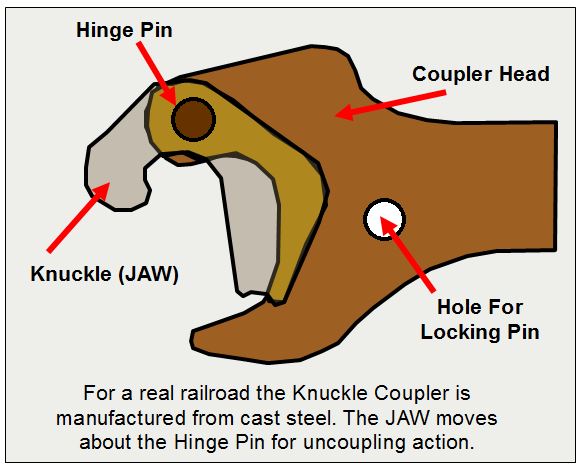 |
Knuckle couplers where invented by Major Eli Janney, a Civil War
veteran, in 1868. The knuckle coupler would best be described as a semi
automatic device that closes and locks the cars together. The closing
operation needs to be safe and efficient to properly lock the cars without
them coming lose and derailing or running wild, and without endangering any
rail workers that might get between the cars.
On real railroads safety is paramount as a worker can be easily
injured or killed through inattention or faulty equipment. The original ‘link
& pin’ coupler was a big cause of rail worker injuries. The ‘cut’ lever
in the corner of cars releases the couplers knuckle to make the uncoupling
much safer.
|
When you think about it, railroad cars need to
get coupled and uncoupled hundreds or thousands of times throughout the life of each car. For that
reason the coupling mechanisms need to be very sturdy, efficient, and reliable. Over the period of
its life a car will be connected to a multitude ode different cars or locomotives, so it makes
sense for the couplings to be standardized and compatible with all cars. It makes sense for the
couplers to be at the same height and position on every car. Unfortunately the system is not that
simple and some variations do exist between coupler types. That said; there is a high level of
standardization with the common types in many parts of the world.
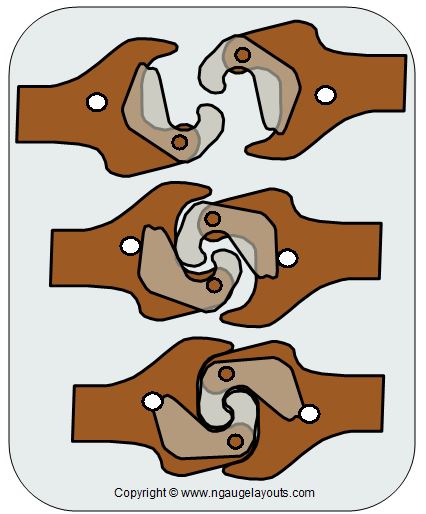 |
Note: I am not very good at
drawing so these sketches are only a rough indication of how train couplers
work.
These three drawings show the
basic process of how two couplers are coupled together. The knuckles on the
couplers must be open to couple the two cars. When the cars are shunted together,
the two knuckles close onto each other. They are then locked from the rear with a
vertical pin that drops a steel block into position just behind the raised casting
of the knuckle. For uncoupling, a pin is pulled up releasing the block that is
locking the knuckle in place. This operation is performed using a lever (or chain)
from the car side.
|
Rapido Couplers
While most sources claim that the original
N-scale couplers were made by Arnold and Rapido, there are also sources that say Trix was also
working on similar products on the same scale at that time. It is believed, and is evident, that
other manufacturers were allowed to use the Rapido coupler design. This was the reason why early N
scale couplers were compatible with products from different manufacturers. Since the Rapido
couplers were the first in line, they left much to be desired. Plain and simple, they were just
square hooks, and did not resemble real-life couplers at all. Also, most modelers use tools to
couple and decouple the couplers. But the Rapido coupler can only be decoupled by hand.
These days, while most manufacturers are designing products with knuckle couplers, there are still
a few who use Rapido couplers.
|
This image shows the top view
and side profiles of common couplers. Please note the images are not exactly to
proportion, but they give a good comparison of how each coupler
looks.
|
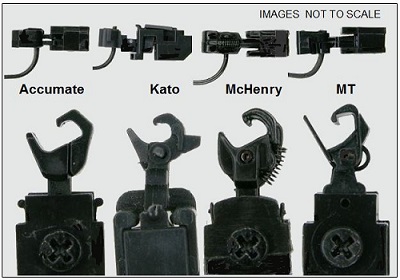 |
|

Click this image to watch a quick N scale video.
|
MTL Couplers (Kadee
Magne-matic Couplers)
Originally HO couplers, Kadee’s
Magne-Matic couplers are now also available in N scale, and are called MTL
couplers. Kadee’s Magne-Matic couplers were first introduced in the HO scale in the
1940s. It was around the 1960s when the company came up with the first N-scale
coupler. The subsequent division and separation of the company into two separate
companies lead to the original company manufacturing larger scales, including Ho,
and the new company, Micro Trains Line manufacturing smaller scales including N-
scale. The company’s N-scale couplers, called MTL couplers, are still one of the
most popular couplers for the N scale.
|
Most knuckle couplers are magnetically
controlled. But most modelers prefer to uncouple by hand. This is because of the reason that
placing magnets along the tracks on a model railroad can lead to breakaways (unwanted uncoupling).
Also, uncoupling by hand allows the uncoupling to be done at any point on the track on not just the
specific places where the magnets have been placed.
Knuckle Coupler Brands
MTL’s knuckle couplers were patented and the
decision of other companies to not pay them the royalties led to emergence of newer brands of
knuckle coupler brands. Knuckle couplers are designed to look more like the real couplers and
hence, are more preferred than Rapido couplers. Major names in the knuckler coupler manufacturing
are: Atlas, Kato, Red Caboose, Intermountain Railway, and Roundhouse. These companies manufacture
and offer their own brands of knuckle couplers. The most recent addition to this list is that of
Athearn Trains, who acquired McHenry. Expanding the original HO line, they have recently started
manufacturing N-scale couplers also. Fleishmann is a well loved and popular brand in
Europe.
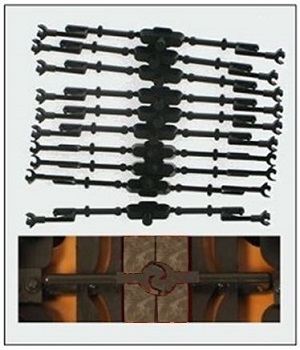 |
Kinematic
Couplers
Kato has introduced the
“kinematic” coupler for their Morning Daylight passenger trains. This knuckle
coupler is incompatible with any other knuckle coupler. Designed to close the gap
between the passenger cars, it allows for the required extension on turns and
bends.
|
Problems With N-Scale
Couplers
The first and foremost problem with N-scale
couplers is that there are so many. The sheer variety and the brands is enough to confuse
anyone.
Once which one to use is decided, the next
problem that arises is the conversion. While most manufacturers now design their products with the
knuckle couplers, there are still manufacturers who manufacture using the Rapido couplers. While
most knuckle couplers are compatible with other varieties, there are some brands that are
incompatible. Also most Rapido couplers are not compatible with any knuckle
couplers.
The conversion of the coupler is thus an
important task. Most modelers consider it easier and more convenient to use the truck mounted
couplers to the body mounted couplers. Another solution to this problem is to look for conversion
tips on the internet. A modeler can also look for local modeling groups for help with the
conversion and the modeling.
Another problem with the N-scale couplers is
the compatibility. All the couplers of the model train need to be the same kind, and if not, it is
a task to figure out compatible brands of couplers.
While Rapido couplers are also easily
available, they do not look authentic and defy the main element of realism of the model railroad. On
the other hand, knuckle couplers look and perform much more like the real-life couplers. Hence,
most modelers prefer the knuckle couplers over Rapido couplers to sustain the realism and
authenticity of the model.
Rapido coupler can only be uncoupled by hand.
Also, while knuckle couplers are easy to use, and can be magnetically uncoupled, most modelers
prefer uncoupling by hand. The placement of magnets on the track to pull the trip pin and create
the uncoupling can sometime not work as planned and lead to breakaways. Hence, the choice to
uncouple by hand
to allow the freedom to uncouple anywhere on the track.
N scale railroading
N scale supplies
Miniature scenery N scale train layouts Layout Plans Kato N Scale Track
|

